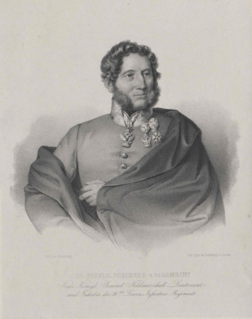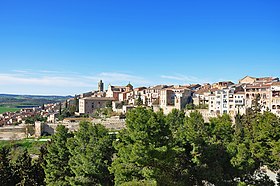
The Peninsular War (1807–1814) was the military conflict fought in the Iberian Peninsula by Spain, Portugal, and the United Kingdom against the invading and occupying forces of the First French Empire during the Napoleonic Wars. In Spain, it is considered to overlap with the Spanish War of Independence. The war started when the French and Spanish armies invaded and occupied Portugal in 1807 by transiting through Spain, and it escalated in 1808 after Napoleonic France had occupied Spain, which had been its ally. Napoleon Bonaparte forced the abdications of Ferdinand VII and his father Charles IV and then installed his brother Joseph Bonaparte on the Spanish throne and promulgated the Bayonne Constitution. Most Spaniards rejected French rule and fought a bloody war to oust them. The war on the peninsula lasted until the Sixth Coalition defeated Napoleon in 1814, and it is regarded as one of the first wars of national liberation and is significant for the emergence of large-scale guerrilla warfare.

In the siege of Tarragona, Catalonia, from 5 May to 29 June 1811, Louis Gabriel Suchet's French Army of Aragon laid siege to a Spanish garrison led by Lieutenant General Juan Senen de Contreras. A British naval squadron commanded by Admiral Edward Codrington harassed the French besiegers with cannon fire and transported large numbers of reinforcements into the city by sea. Nevertheless, Suchet's troops stormed into the defenses and killed or captured almost all the defenders. The action took place at the port of Tarragona, Catalonia, on the east coast of Spain during the Peninsular War, part of the Napoleonic Wars.

The Battle of Saguntum saw the Imperial French Army of Aragon under Marshal Louis Gabriel Suchet fighting a Spanish army led by Captain General Joaquín Blake. The Spanish attempt to raise the siege of the Sagunto Castle failed when the French, Italians, and Poles drove their troops off the battlefield in rout. The action took place during the Peninsular War, part of the Napoleonic Wars. Sagunto lies a short distance from the east coast of Spain, about 30 kilometres (19 mi) north of Valencia.

In the Battle of Zújar of the Peninsular War, part of the Napoleonic Wars, on 9 August 1811 an Imperial French division from Nicolas Soult's army attacked a Spanish division belonging to Manuel Alberto Freire de Andrade y Armijo's Army of Murcia. The French division, led by Nicolas Godinot, defeated Joseph O'Donnell's Spanish division with heavy losses. Zújar is located on Route 323, 13 kilometres (8 mi) northwest of Baza, Granada in Spain.

The Battle of Molins de Rei or Battle of Molins de Rey or Battle of Molins del Rey saw an Imperial French corps led by Laurent Gouvion Saint-Cyr attack a Spanish army temporarily led by Theodor von Reding and the Conde de Caldagues because its commander Juan Miguel de Vives y Feliu was absent. Saint-Cyr outmaneuvered his opponents, distracting them with a false attack in front while sending the bulk of his force across Llobregat River in a turning movement around the Spanish right flank. The Spanish defensive lines crumbled and the French captured 1,200 soldiers, all the Spanish artillery and Caldagues himself. The Peninsular War engagement was fought near Molins de Rei, located 15 kilometres (9 mi) west of Barcelona, Catalonia, Spain.
Juan de Courten (younger) was a Spanish general who led an infantry division during the Peninsular War against the First French Empire. In 1810, he was promoted to mariscal de campo, a Spanish rank between brigadier general and lieutenant general, and therefore equivalent to major general. The following year he was captured at the conclusion of the Siege of Tarragona. In 1818, he received an important military decoration.

In the Battle of La Bisbal on 14 September 1810 a Spanish division led by Henry O'Donnell and supported by an Anglo-Spanish naval squadron led by Francis William Fane and Charles William Doyle surprised an Imperial French brigade commanded by François Xavier de Schwarz. The Imperial troops were from the Confederation of the Rhine, a collection of small German states that were allied to Napoleon. Part of a division led by Marie François Rouyer, Schwarz's brigade was almost completely wiped out, most of its soldiers being taken prisoner along with its commander. One of the few Allied casualties was the capable O'Donnell, wounded in the foot. The battle occurred during the Peninsular War, part of the Napoleonic Wars.

The siege of Figueras, which lasted from 10 April to 19 August 1811, saw the Spanish garrison of Sant Ferran Castle led by Brigadier General Juan Antonio Martínez defend against an Imperial French force commanded by Marshal Jacques MacDonald and his deputy Louis Baraguey d'Hilliers. Martínez and his men held out much longer than expected but were eventually starved into surrendering the fortress, which was near Figueres. The action occurred during the Peninsular War, part of the Napoleonic Wars.

Joaquín Ibáñez Cuevas y de Valonga, Baron de Eroles led a Spanish division against Imperial France in a number of actions during the Peninsular War. A lawyer at the outbreak of war, he took command of guerillas who resisted the French occupation of his native Catalonia. He fought at Molins de Rey in 1808. Captured by the French at Gerona in 1809, he later escaped. By 1810 he led one of four regular divisions of the Army of Catalonia. In November 1810 he destroyed a French convoy at La Junquera. His men were driven off Montserrat Mountain on 25 July 1811. His division wiped out a French column at Col de Balaguer on 18 January 1812. Six days later he was badly beaten at Altafulla when he mistakenly attacked Maurice Mathieu's superior French force in a thick fog. On 5 March he defeated a French force that attacked him at Roda de Isábena. Later in the war he liberated a number of towns from the French.

The Battle of Manresa and Battle of Vilafranca from 21 March to 5 April 1810 saw a Spanish division led by Juan Caro and Luis González Torres de Navarra, Marquess of Campoverde attack an Imperial French brigade commanded by François Xavier de Schwarz.

David-Maurice-Joseph Mathieu de Saint-Maurice de La Redorte or Maurice Mathieu was a French general during the Napoleonic Wars.
The Battle of El Pla was a battle on 15 January 1811 between an Imperial French column made up of two Italian brigades on one side and a Spanish division under the command of Pedro Sarsfield on the other. The Spanish troops held steady and repulsed the attack of the first brigade, then counterattacked and defeated both brigades. The combat occurred during the Peninsular War, part of the Napoleonic Wars. The action was fought near El Pla de Santa Maria, north of Valls, Catalonia, Spain.

In the Battle of Castalla a small Spanish army commanded by Joseph O'Donnell advanced to attack an Imperial French division under the leadership of Jean Isidore Harispe. O'Donnell's battle plan was poorly conceived and the outnumbered French smashed his center column before his right and left wings could intervene. The engagement occurred during the Peninsular War, part of the Napoleonic Wars. The battle was fought near Castalla, 32 kilometres (20 mi) north-west of Alicante, Spain.

Louis Jean Nicolas Abbé became a French general during the Napoleonic Wars. He enlisted as a foot soldier in the royal army in 1784 and was a non-commissioned officer by 1792. He spent most of the French Revolutionary Wars fighting in Italy. In 1802 he joined the Saint-Domingue expedition. He was appointed colonel in command of the 23rd Light Infantry Regiment in 1803 and led the unit at Caldiero, Campo Tenese, Maida, and Amantea. Promoted to general of brigade in 1807, he led a brigade in 1809, fighting at Sacile, Caldiero, the Piave, Tarvis, Raab, and Wagram.

In the Battle of Montserrat a force of Spanish irregulars led by Joaquín Ibáñez, Baron de Eroles defended Montserrat Mountain against two Imperial French divisions under the command of Marshal Louis Gabriel Suchet. The minor action occurred during the Peninsular War, part of the Napoleonic Wars. The battle was fought near the Santa Maria de Montserrat Monastery, which is located on the mountain 36 kilometres (22 mi) northwest of Barcelona, Catalonia, Spain.

The siege of Olivença or Olivenza occurred on 19-22 January 1811 when French General Jean-de-Dieu Soult successfully undertook the capture of the run-down Spanish fortress of Olivenza in western Spain during the Peninsular War.

The siege of Mequinenza saw a 16,000-man Imperial French corps commanded by Louis Gabriel Suchet invest a 1,000-strong Spanish garrison under Colonel Carbon. Mequinenza and its castle were captured by the French after an operation lasting about three weeks. The action occurred during the Peninsular War, which formed part of the Napoleonic Wars. Mequinenza is located at the confluence of the Ebro and Segre Rivers about 211 kilometres (131 mi) west of Barcelona.

The Battle of Saguntum saw the Imperial French Army of Aragon under Marshal Louis Gabriel Suchet defend against a Spanish army led by Captain General Joaquín Blake. The Spanish attempt to raise the siege of the Sagunto Castle failed when the French, Italians, and Poles drove their troops off the battlefield in rout. The 20,000 French inflicted 6,000 casualties on their more numerous opponents, including many prisoners, while sustaining only about 1,000 casualties.

Giuseppe Federico Palombini or Joseph Friedrich von Palombini became an Italian division commander during the Napoleonic Wars. He joined the army of the Cispadane Republic in 1796 and fought at Faenza in 1797. He became commander of a dragoon regiment in 1798. He became commander of the Napoleone Dragoons, of the Cisalpine Republic army, in 1802. He fought as an ally of the French at Kolberg and Stralsund in 1807. He married the daughter of Jan Henryk Dąbrowski (Dombrowski) in 1806.

The Cardedeu order of battle lists the troops that fought in the Battle of Cardedeu and several other battles fought between June and December in the Spanish province of Catalonia during the Peninsular War. In February 1808, Imperial French forces treacherously seized Barcelona on 29 February and Sant Ferran Castle on 15 March as well as other fortresses in Spain. The Dos de Mayo Uprising broke out when the Spanish people found that Emperor Napoleon deposed the Spanish royal family and set up his brother Joseph Bonaparte as their new king. The 12,000 Imperial French soldiers under Guillaume Philibert Duhesme occupying Catalonia were beaten at the Battles of El Bruch and Gerona in June. Though Duhesme was reinforced by another French division, the Spanish defeated him at the Second Siege of Gerona in July and August. With Duhesme blockaded in Barcelona, Napoleon appointed Laurent Gouvion Saint-Cyr as commander of the VII Corps, added two good divisions and other troops to his force, and ordered him to relieve Barcelona. Saint-Cyr succeeded in this task, winning the battles of Roses, Cardedeu and Molins de Rei in December.

















